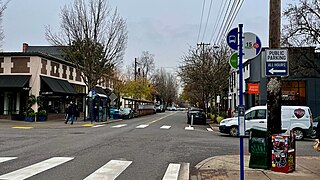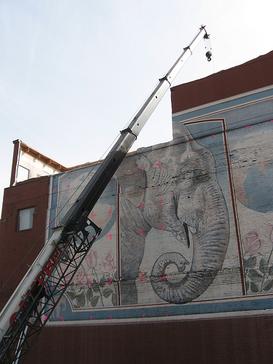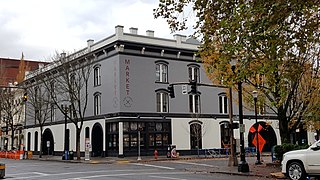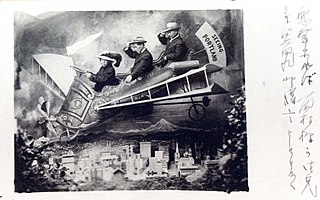
The Portland Saturday Market is an outdoor arts and crafts market in Portland, Oregon. It is the largest continuously operated outdoor market in the United States. It is held every Saturday from the beginning of March through December 24, in Tom McCall Waterfront Park underneath Burnside Bridge and south of the bridge, as well as within an adjacent plaza just across Naito Parkway, extending west to the Skidmore Fountain. The market's hours of operations are from 10 a.m. to 5 p.m. on Saturdays, and admission is free. The market is accessible by foot, bicycle, Segway, and TriMet's MAX Light Rail line which stops near the market at the Skidmore Fountain stop. The market has over 400 members and generates an estimated $12 million in gross sales annually. It has become a central economic engine for the historic Old Town Chinatown neighborhood, and attracts an estimated 750,000 visitors to this area each year.'

Downtown Portland is the central business district of Portland, Oregon, United States. It is on the west bank of the Willamette River in the northeastern corner of the southwest section of the city and where most of the city's high-rise buildings are found.

The Northwest District is a densely populated retail and residential neighborhood in the northwest section of Portland, Oregon, United States. Craftsman-style and Old Portland-style houses are packed tightly together with old apartment buildings and new condominiums, within walking distance of restaurants, bars, and shops. The Portland Streetcar's first line terminates there, connecting the district to the Pearl District, Downtown Portland and points south to the South Waterfront, and several TriMet bus lines also serve the district.

The Skidmore Fountain is a historic fountain in Portland, Oregon, United States.

The White Stag sign, also known as the "Portland Oregon" sign, is a lighted neon-and-incandescent-bulb sign located atop the White Stag Building, at 70 NW Couch Street in downtown Portland, Oregon, United States, facing the Burnside Bridge. The sign faces westbound traffic as it enters downtown Portland coming across the Willamette River. The sign was acquired by the City of Portland in September 2010, and the lettering was changed to read "Portland Oregon" in November 2010.

William Sumio Naito was an American businessman, civic leader and philanthropist in Portland, Oregon, U.S. He was an enthusiastic advocate for investment in downtown Portland, both private and public, and is widely credited for helping to reverse a decline in the area in the 1970s through acquiring and renovating derelict or aging buildings and encouraging others to invest in downtown and the central city.

The Fubonn Shopping Center is an enclosed shopping mall in the Powellhurst-Gilbert neighborhood of Portland, Oregon, in the United States. The mall claims to be the largest Asian mall in Oregon and lists 29 stores as tenants in November 2011. The mall is located at SE 82nd Avenue and SE Woodward Street. It is anchored by the Fubonn Supermarket, a large Asian grocery and housewares store. The Oregonian calls it "the eastside's answer to Uwajimaya".

The Merchant Hotel, also known as the Merchants' Hotel, is a historic former hotel building in Portland, Oregon, United States. It is located at 121 N.W. Second Avenue in Old Town Chinatown. It is a contributing property in the Portland Skidmore/Old Town Historic District, which was listed on the U.S. National Register of Historic Places in 1975 and designated a National Historic Landmark District in 1977. It is one of the few remaining examples of Victorian Italianate, cast iron architecture on the West Coast. It occupies half of a city block, specifically along the south side of N.W. Davis Street from Second to Third Avenues.

Chinatown Gateway is an outdoor paifang and sculpture which serves as an entrance to Portland, Oregon's Old Town Chinatown neighborhood, in the United States. The gate was proposed by the Chinese Consolidated Benevolent Association in 1984. Architect Yu Tang Wang and artist Sun Chau completed the gate's design, which was built by Ting Hwa Architects in Taiwan. It was then shipped to Portland and installed in one week before being dedicated in November 1986. It cost $256,000 and was the largest of its kind in the United States until one in Washington, D.C. was completed several months later.

The Packy mural was a public artwork depicting the elephant Packy, painted on the Skidmore Fountain Building in Portland, Oregon's Old Town Chinatown neighborhood. The artwork was designed by Eric Larsen and painted in 1990 by North Pacific Sign and Design, but was destroyed during the building's 2008 renovation to become the new headquarters for Mercy Corps.

Hung Far Low was a Chinese restaurant in Portland, Oregon's Old Town Chinatown neighborhood, in the United States.

The United Carriage and Baggage Transfer Building is an historic building in Portland, Oregon's Old Town Chinatown neighborhood, completed in 1886. It is a contributing property in the Portland Skidmore/Old Town Historic District, which was listed on the U.S. National Register of Historic Places in 1975 and designated a National Historic Landmark District in 1977. Its ground floor currently houses the Pine Street Market.

Ankeny Plaza, is a historic square located at the intersection of Southwest Ankeny and Naito Parkway in Portland, Oregon's Old Town Chinatown neighborhood, in the United States. It contains Skidmore Fountain.

Naito Parkway is a major thoroughfare of Portland in the U.S. state of Oregon. It was formerly known as Front Avenue and Front Street and was renamed in 1996 to honor Bill Naito. It runs between SW Barbur Boulevard and NW Front Avenue, and adjacent to Tom McCall Waterfront Park through Downtown Portland.

Chinatown, Toronto is a Chinese ethnic enclave located in the city's downtown core of Toronto, Ontario, Canada. It is centred at the intersections of Spadina Avenue and Dundas Street, West.

The history of Japanese-Americans and members of the Japanese diaspora community, known as Nikkei (日系), in the greater Portland, Oregon area dates back to the early 19th century. Large scale immigration began in the 1890s with the growth of the logging and railroad industries in the Pacific Northwest, after the Chinese Exclusion Act of 1882 limited migration of new cheap labor from China and those other areas controlled by the Qing dynasty.
Northwest Portland is one of the sextants of Portland, Oregon, United States.

The Republic Cafe and Ming Lounge are a Chinese restaurant and bar in Portland, Oregon's Old Town Chinatown, in the United States. The restaurant is one of Portland's oldest, established in 1922, and continues to operate under the Mui family's ownership. Serving Chinese cuisine such as Mongolian beef, General Tso's chicken, chop suey, and egg foo young, the Republic Cafe has been described as a "staple" of the neighborhood and the city's Chinese American history. Celebrities have visited the restaurant which has also seen several longtime employees. Ming Lounge is among the city's oldest bars and has been characterized as "seedy".

The Portland Skidmore/Old Town Historic District is an historic district in Portland, Oregon's Old Town Chinatown neighborhood, in the United States. The approximately 20-block area, center around Burnside Street and named after the Skidmore Fountain, is known for exhibiting Italianate architecture, though High Victorian Italianate, Renaissance Revival, Richardsonian Romanesque, and Sullivanesque styles are also present. In addition to Skidmore Fountain, structures within the district's boundaries include the Blagen Block, Delschneider Building, Hallock and McMillin Building, New Market Theater, New Market Alley Building, New Market Annex, and Poppleton Building.

The Portland New Chinatown/Japantown Historic District is a historic district in Portland, Oregon's Old Town Chinatown neighborhood, in the United States. The district is listed on the National Register of Historic Places.





















